NEET Biology Notes For Morphology Of A Flowering Plants
Morphology deals with the study of forms and features of different plant organs such as roots, stems, leaves, flowers, seeds, fruits, etc. The body of a flowering plant can be divided into two fundamental parts:
- An Underground Root System And
- An Aboveground Shoot System. The Root System Grows Downwards Into The Soil Anchors The Plant Firmly In The Soil And Absorbs Water And Various Dissolved Minerals From It. The Shoot Supports Foliage Leaves And Helps In The Conduction Of Water And Mineral Substances From The Soil And Food Material.
NEET Biology Notes For Morphology Of A Flowering Plants Life Span Of A Flowering Plant
The Life Span Of A Flowering Plant Can Be Any Of The Following Forms:
Annual: The life cycle is completed in one season or a few weeks to a few months. Examples are wheat, maize, and Euphorbia prostrata.
Biennials: The life cycle is completed in two seasons: vegetative growth occurs in the first season and food is stored and reproduction occurs in the second season, for example, henbane. Radish, carrot, and turnip are biennials in colder areas and annuals in warmer areas.
Perennials: The plant lives for a few to many years and may bear flowers and fruits every year (polycarpic). Bamboo (Bambusatulda) and agave are monocarpic, i.e., flowering occurs only once in life lifetime.
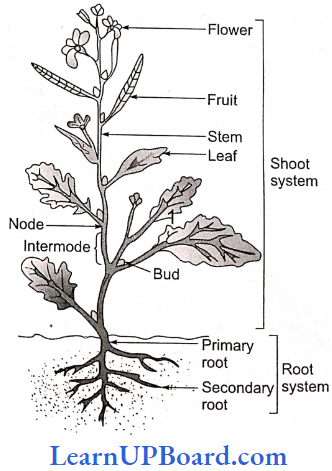
NEET Biology Notes For Morphology Of A Flowering Plants Habit Of Plants
Herb: Stem is soft, less than 2 m in height.
Shrub: Perennial woody stem with medium height, tiunk is absent for example, Capparis, Rosa, etc.
Trees: Woody stems of great height; the stem is called a trunk. An unbranched stem is called caudex or columnar, for example, a palm. An erect stem with swollen nodes is called a culm, for example, bamboo.
Excurrent: The lateral branches of the trunk do not compete with the stem, for example, Finns, Casuarina, and Eucalyptus.
Deliquescent: The main stem or trunk disappears after some time and the crown is dome-shaped, for example, Dalbergia, Ficus benghalensis.
Read and Learn More NEET Biology Notes
NEET Biology Notes For Morphology Of A Flowering Plants Root
Roots develop from the radicle of the seed. They are non-green, underground, positively geotropic, and negatively phototropic. Roots usually do not bear buds, but buds are present for vegetative propagation in sweet potato (Ipomoea) and Indian redwood (Dalbergia). They do not bear nodes and internodes. They have unicellular root hair. Lateral roots arise endogenously, i.e., from the pericycle.
Types Of Roots: Roots Are Mainly Of Two Types
- Tap Root: They develop from seed radicles. The primary root grows and gives rise to secondary and tertiary roots forming a tap root system. For example, dicots.
- Adventitious Roots: They develop from any part of the plant body other than the radicle. For example, monocots. They are usually shallow surface feeders such as fibrous roots of grasses.
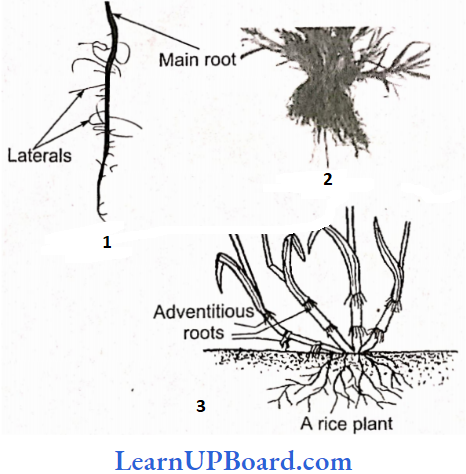
Parts Of Root
Root Cap: At the apex of the root, a smooth cap-gaped structure is present which is called as root cap. It is protective. Multiple root cap is found in trial roots of screwpine (Pandanus). In hydrophytes, the root cap is either absent or replaced by a root pocket, for example, Pistia, Lemna, and Eichhomia.
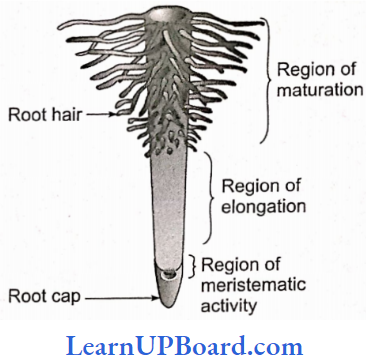
Zone Of Cell Formation Or Division: The cells of this region are in an active state of division and their number increases continuously. No vacuoles or small vacuoles are present. It extends to a few millimeters.
Zone Of Cell Elongation: Maximum growth in the cells occurs in this zone. A large central vacuole is present.
Zone Of Cell Maturation: The cells are differentiated into permanent tissues depending upon the functions they have to perform. Root hairs are also present in this zone. In hydrophytes, root hairs are absent because they absorb water through the general body surface.
Modifications Of Tap Roots
- Storage/Fleshy Roots
- Fusiform: Example, radish (Raphamts sativus).
- Conical: Example, carrot (Daucus carota).
- Napiform: Example, turnip (Brassica rapa), beetroot (Beta vulgaris).
- Respiratory Root (Pneumatophores): Example, Avicennia. Sonneratia.
- Respiratory Root (Pneumatophores): Example, Avicennia, Sonneratia.
- Nodulated Roots: Example, Pisum sativum, Cicer arietinum.
” morphology of angiosperms”
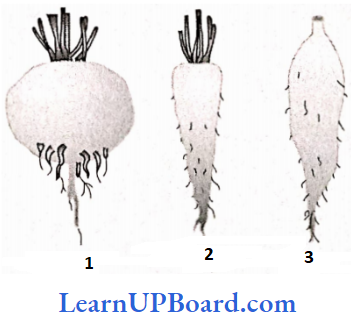
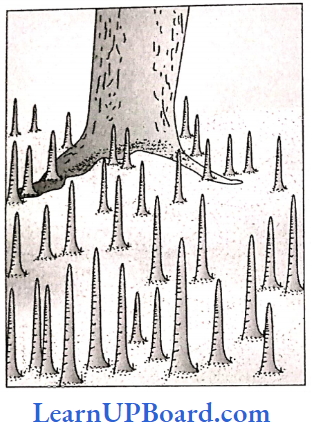
Modifications Of Adventitious Roots
- Storage Roots
- Tuberous: Example, sweet potato (Ipomoea batatas)
- Fasciculated: Example, Asparagus, Dahlia.
- Palmate: Example, orchis.
- Nodulose: Example, mango ginger (Curcuma amada)
- Beaded Or Moniliform: Example, Portulaca, Momordica.
- Annulated: Example, ipecac (Psychortai)
- Adventitious Roots That Provide Extra Support
- Prop Roots: Example, old banyan tree (Ficus benghalensis)
- Stilt Roots: Example, sugarcane, maize.
- Climbing Roots: Example, Pothos, Piper.
- Buttress Roots: Example, Bombax.
- Adventitious Roots With Special Function
- Respiratory Roots: Example, Jussiaea.
- Assimilatory Roots: Example, Tinospora, Trapa.
- Haustoria: Example, Cuscuta.
- Hygroscopic Roots: Example, orchids.
- Contractile Roots: Example, saffron (Crocus), Freesia.
- Root Thorns: Example, Pothos arinatus, Acanthorhiza.
- Foliar/Epiphyllous/Leaf Roots: Example, Btyophyllum, Bignonia, Salvinia.
NEET Biology Notes For Morphology Of A Flowering Plants Stem
Stem is formed by the prolongation of the plumule of the embryo. It is positively phototropic negatively geotropic and hydrotropic. It bears nodes and internodes. The leaf-bearing part of the stem is called the shoot. It has buds. A bud is a condensed immature or embryonic shoot having a growing point surrounded by immature leaves. Cabbage is the largest bud.
According To Nature, Buds Can Be:
- Vegetative: Form leafy shoots.
- Floral: Form flowers.
- Mixed: Form both vegetative and floral characters.
According To Position, Buds Can Be Lateral Or Terminal. Lateral Buds Are Of Four Types:
- Axillary: Present in the axil of a leaf.
- Accessory: Additional buds occur either on the side or above the axillary bud.
- Extra-axillary: Developing on the node but outside the leaf base.
- Adventitious: Formed from places other than nodes. These can be:
- Foliar: Example, Biyophyllum, Begonia.
- Radical: Example, Dalbergia, Ipomoea batata (sweet potato).
- Cauline: Example, jackfruit.
Types And Modifications Of Stem
Aerial Stems (Epiterranean Stem): It may be reduced, erect, or weak.
- Reduced: The stem is reduced to a disc, for example, radish, carrot, turnip.
- Erect Stem: The stem is strong and upright, for example, maize, wheat, and mango. An erect stem with swollen nodes is called a culm (for example, bamboo).
- Weak Stem: These are thin, soft, and weak and need support. These can be upright or prostrate. These are of the following types.
- Creepers: The stem creeps on earth and the roots arise at the nodes, for example, grasses, strawberries, and Oxalis.
- Trailers: The stem creeps on the ground but the roots do not arise at the nodes. They may be of the following types:
- Prostrate Or Procumbent And Diffuse: Example, Evolvulus, Tribulus.
- Decumbent: Example, Tridax.
- Diffuse: Example, Boerhaavia.
- Lianas (Stem Climber): Woody perennial climbers found in tropical rainforests are lianas. They twine themselves around tall trees to secure sunlight, for example, Hiptage, and Bauhinici vahlii (phanera).
- Climbers: Plants are with long weak stems and have organs of attachment to climb objects. They may be:
- Rootlet Climber: Example, Tecoma, Pothos, Piper betel (paan).
- Hook Climber: In Bougainvillea, Duranta.
- Tendril Climber: Tendrils are thread-like structures that help in climbing plants.
- Entire Leaf: Leaf tendrillar, for example, Lathyrus sativus.
- Leaflet: Leaflet tendrillar for example, Pisum.
- Twiners: The stem body twines around the support without any special organ of attachment, for example, Cuscuta, Dolichos, and Quisqualis.
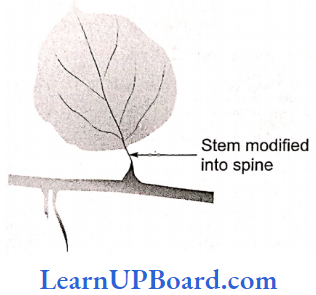
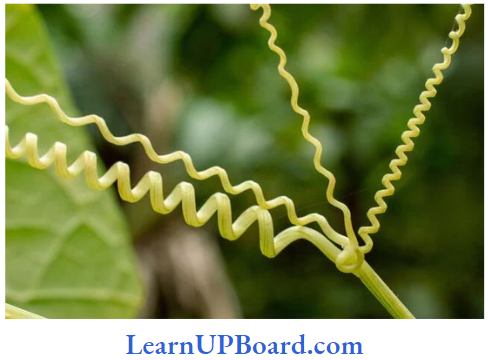
Sub-aerial Stems
- Runner: It is an elongated, prostrate, aerial branch with long internodes and roots that strike at nodes, for example, Oxatis, grasses, Hydrocotyl
- Sucker: It arises from the axillary bud of the underground part of the stem. The branch creeps below the soil surface grows obliquely upward and produces new shoots. Examples, are Mentha, Chrysanthemum, and Rosa.
- Offset: Short horizontal branch producing a cluster of leaves above and a cluster of roots below, for example, Pistia, Eichhornia.
- Stolon: It is a subterranean long lateral branch arising from the base of the stem, for example, Colocasia. It first grows obliquely upward and then bends down to touch the ground surface.
“morphology of flowers “
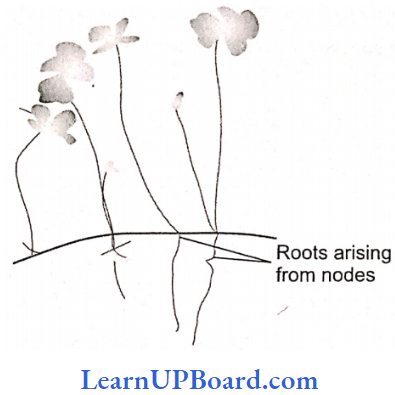
Underground Stems
- Rhizome: It grows parallel or horizontally to the soil surface. It bears nodes, internodes, buds, and scaly leaves, for example, ginger, banana, turmeric, and ferns. It is of two types:
- Rootstocks: It is upright or oblique with the tip almost reaching the soil surface, for example, Dryopteris.
- Straggling: It is horizontal and branched. Branching may be
- Racemose: The Axis is monopodial, for example, Saccharum, lotus.
- Uniparous Cymose: Axis is sympodial, for example, Zingiber officinale (ginger), Curcuma domestica (turmeric), and Canna.
- Tuber: It is the terminal portion of underground stem branches that are swollen on account of accumulation of food, for example, potato, Jerusalem artichoke (Helianthus tuberosus).
- Corm: It grows vertically to the soil surface. It bears nodes, internodes, buds, and scaly leaves, for example, Colocasia, Gladiolus, Colchicum, Crocus, and Amorphophallus.
- Bulb: Stem is reduced and disc-shaped. The bud is surrounded by many concentric leaves. The leaf bases are fleshy and edible, for example, onion, lily, and garlic. The bulb may be tunicated or scaly.
- Tunicated (Layered Or Laminate): The bulb is covered with a dry membranous sheath of scales called a tunic. These bulbs may be again of two types:
- Simple Tunicated: Onion, Tulipa, and Narcissus.
- Compound Tunicated Bulb: Garlic.
- Scaly Or Imbricate Or Naked Bulb: Tunic is absent, for example, lily.
- Tunicated (Layered Or Laminate): The bulb is covered with a dry membranous sheath of scales called a tunic. These bulbs may be again of two types:
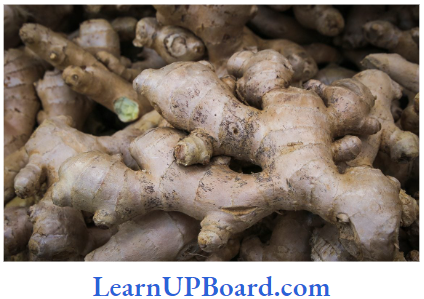

Special Stem Modifications
- Phylloclade: It is a green flattened or rounded succulent stem with leaves either feebly developed or modified into spines, for example, Opuntia, or Casuarina.
- Cladode: Phylloclade with one intemode is called cladode, for example, Asparagus, and Ruscus.
- Thorn: It is the modification of axillary buds, for example, Bougainvillea, Duranta, Carrisa, Alhagi, etc. Thoms of Alhagi possess flowers and in Duranta, thorns bear smalt foliage leaves. Thoms of Carissa are terminal and branched.
- Stem Tendril: Example, Vitis, Passiflora.
- Bulbils: A condensed auxiliary bud (vegetative) is called a bulbil. It helps in vegetative reproduction, for example, Dioscorea, Glabba, Agave, and Oxalis.
Branching Of Stem: Branching is defined as the mode of arrangement of branches on the stem. It is of two types:
- Lateral Branching: Branches are produced laterally from the main stem. It may be racemose or cymose.
- Racemose Type: The main stem grows indefi¬nitely by the terminal bud and produces branches later in the acropetal succession, for example, Casuarina, Poly alt hia, etc.
- Cymose Type: The growth of the main stem is limited and lateral branches produced by the main stem show more vigorous growth. It may be of the following types:
- Uniparous Cyme: When one lateral branch is produced at a time. It has two distinct types: helicoid (for example, Saraca) and scorpoid (for example, Vine).
- Biparous Cyme: When two lateral branches develop at a time, for example, Mirabilis, Datura.
- Multiparous Cyme: When more than two branches develop at a time, for example, Croton, Euphorbia.
- Dichotomous Branching: When the terminal bud gives out two branches of equal size in a forked manner, for example, Pandanus, or Hyphaene.
NEET Biology Notes For Morphology Of A Flowering Plants Leaf (Phylopopium)
Leaves are lateral, flat, green, and expanded part of plants that arise from nodes on the stem or branches. Usually leaf has a bud in its axil. The chief functions of leaf is photosynthesis and transpiration. All leaves of a plant are collectively called phyllome. The leaves are of the following types:
- Cotyledonary Leaves: These are embryonic or seed leaves.
- Cataphylls: These are scale leaves. These may store food also, for example, onions.
- Hypsophylls or bract leaves.
- Prophylls: The first formed leaves.
- Floral Leaves: Include sepals, petals, or perianth.
- Sporophylls: Bear spores; this is also used for stamens and carpels.
- Foliage Leaves: The green leaves of the plant are called foliage leaves.
“plus one botany short notes pdf “
Parts Of A Leaf: A leaf consists of the following three parts: leaf base, petiole, and lamina.
- Leaf Base (Hypopodium): Leaves are attached to the stem by the leaf base. In some plants, the leaf base becomes swollen and is called pulvinus which is responsible for sleep movement, for example, Cassia, Mimosa, Bean. In some plants, the leaf base expands into a sheath (sheathing leaf base), for example, grasses, and bananas (monocots). When the leaf base partially encloses the stem, it is called auriculate or semi-amplexicaul, for example, prickly poppy, Calotropis procera (Madar).
- If it completely encloses the stem, it is called amplexicaul, for example, Sonchus, Polygonum.
- In some plants, minute appendages arising from the leaf base are known as stipules. Leaves with stipules are called stipulate (for example, Rosa, Polygonum) and those without stipules are called exstipulate, for example, Ipomoea.
- Types Of Stipules: Depending upon duration, they can be:
- Caducous: Fall off before unfolding of leaf, for example, Michelle Champaca.
- Deciduous: Fall off soon after unfolding of leaves, for example, Cassia tora and Dillenia indica.
- Persistent: Remain attached to the leaf throughout life, for example, rose, pea, etc. On The Basis Of Structure And Relation To The Leaf, Stipules Are Classified As:
- Free Lateral: These are free; and present on both sides of the leaf base, for example, Hibiscus rosasinesis.
- Scaly: Small dry scales present on both sides of the legal base, for example, Desmodium, etc.
- Intrapetiolar: These are situated between the petiole and axis, for example, Gardenia.
- Foliaceous: Large, green-leafy structures, two in number, for example, pea (Pisum) and sweet pea (Lathyrus).
- Tendrillar: One tendri liar stipule lies on each side of the petiole, for example, Smilax.
- Petiole (Mesopodium): Petiole in Eichhornia becomes spongy and bulbous. In orange (citrus plants), the petiole becomes winged. Petiole is modified into ten¬drils in Clematis. In Australian acacia, the petiole is modified into a leaf-like sickle-shaped phyllode.
- Lamina (Epipodium): The broad fiat part of the leaf is the lamina (leaf blade).
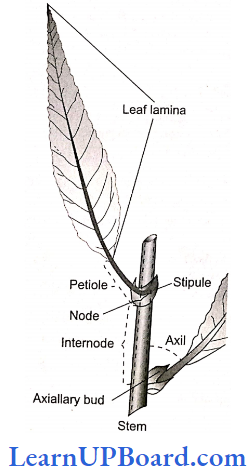
Types Of Leaf
- Simple Leaf: Leaf which may be entire or incised and the incisions do not touch the midrib, for example, mango, or banyan.
- Compound Leaf: The leaf blade is incised up to the midrib or petiole and thus divides it into two or more leaflets.
They Are Of Two Types:
- Pinnately Compound Leaves: Rachis bears several lateral leaflets. These may be of the following types:
- Unipinnate: They are of two types:
- Paripinnate: Example, Cassia, Sesbania.
- Imparipinnate: Example, Rosa, Tephrosia, Azadirachta,
- Bipinnate: Example, Acacia, Mimosa, Delonix.
- Tripinnate: Example, Morinaa, Melia, Azadirachta.
- Decompound: Example, Daucus carota (carrot), Parthenium, Coriandrum.
- Unipinnate: They are of two types:
- Palmately Compound Leaves: It has no rachis and all the leaflets are joined to a common joint at the tip of the petiole. They may be of the following types:
- Unifoliate: Example, Citrus.
- Bifoliate: Example, Biginonia grandiflora, Princepia. Balanites, Hardwickia.
- Trifoliate Or Ternate: Example, Medicago, Aegle, Oxalis, Dolichos.
- Quadrifoliate: Example, Marsilea, Paris quadrifolia.
- Multifoliate: Example, Cleome, Bombax.
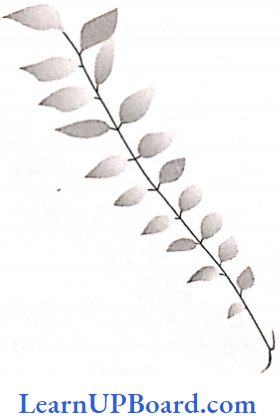
“morphology of flowering plants short notes for neet “
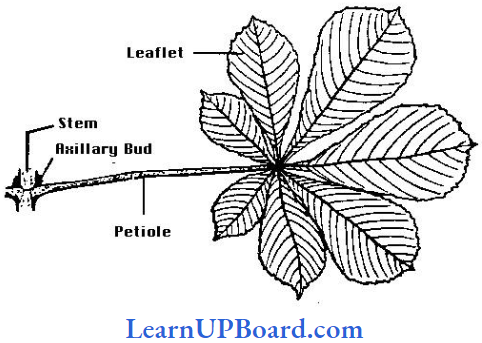
Venation In Leaves: The arrangement of veins on the lamina is called venation. It is of three types: reticulate, parallel, and furcate.
- Reticulate Venation: The branches of veins form a network, for example, dicots. However, there are some dicots that show parallel venation, for example, Calophyllum, Eryngium, and Corymbium. It Can Be Of Two Types:
- Pinnate Or Unicostate: for example, mango, banyan, China rose.
- Palmate Or Multicostate:
- Convergent, for example, Ztzyphus, Smilax and
- Divergent, for example, castor (Ricinus), Luffa, and Vitis (grapevine).
- Parallel Venation: The veins and veinlets remain parallel to each other, for example, in monocots. Some monocots that show reticulate venation are, for example, Smilax, Dioscorea, and Alocasia. This is Two Types:
- Pinnate Or Unicostate Parallel Venation: Example Banana {Musa paradisiaca), canna.
- Palmate Or Multicostate:
- Convergent, bamboo, grass or
- Divergent, for example, fan palm.
- Furcate: The veins branch dichotomously but the finer branches do not form reticulum. It is common in ferns (for example, Adiantum). Among higher plants, it is seen in Cirencester.
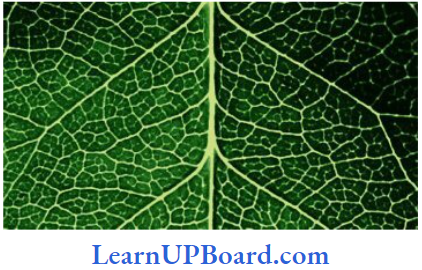
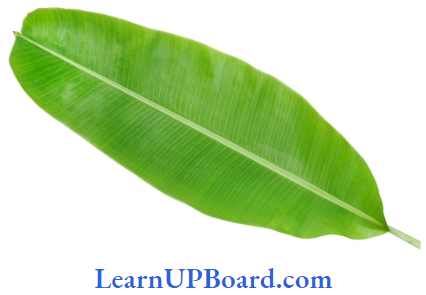
Phyllotaxy: It is the mode of arrangement of leaves on the stem or its branches. It is of the following types:
- Alternate: Single leaf arising at each node, for example, mustard.
- Opposite: Leaves occurring in pairs at the node. They May Be:
- Decussate: Leaves that stand at a right angle to the next upper or lower pair, for example, Ocinunn sanctum (sacred basil). Zinnia.
- Superimposed: Leaves that stand parallel to the next upper or lower pair, for example, Psidium (guava), Eugenia jambolana (Jamun).
- Whorled: Leaves occurring in more than two at each node, for example, Nerium, Alstonia.
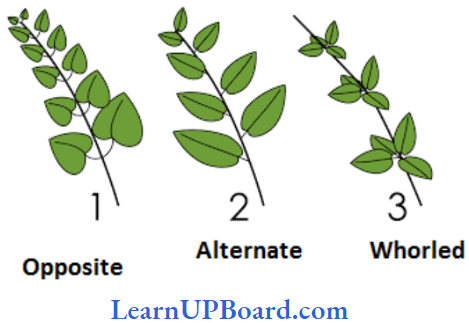
Heterophyily: The occurrence of more than one type of leaves on the same plant is known as heterophyily. It is of three types:
- Developmental Heterophyily: Leaves of different forms and shapes occur at different periods or places on the same plant, for example, mustard, Sonchus, and Eucalyptus.
- Habitual Heterophyily: Leaves differ in their shape and incisions due to their habit or nature, for example, Artocarpus, Heterophyllus (jack fruit), and Ficus heterophylla.
- Environmental Heterophyily: This type is found in aquatic plants where the submerged leaves differ from the floating and aerial leaves, for example, Sagittaria, Ranunculus aquatilis, and Limnophilia heterophylla.
Inflorescence: The arrangement of flowers and mode of distribution of flowers on the shoot system of a plant is called inflorescence.
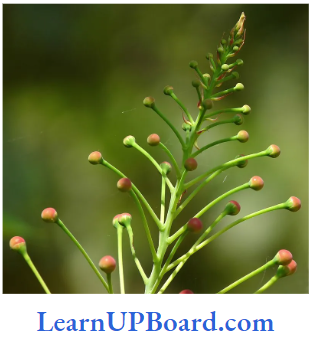
Racemose (Indefinite) Inflorescence: The main axis of inflorescence does not end in a flower but continues to grow. The development of flowers is acropetal. The opening of flowers is centripetal. It is of the following types:
- Raceme: Peduncle has bisexual and pedicellate flowers arranged acropetally, for example, larkspur, mustard, and radish.
- Spike: Peduncle has bisexual and sessile flowers, for example, Achyranthes, and Adhathoda.
- Corymb: The main axis is short. Lower flowers have longer pedicels than upper ones so that all the flowers are brought more or less to the same level, for example, Iberis, and Capsella.
- Compound Corymb, for example, cauliflower.
- Umbel: The main axis is reduced very much and all flowers appear to be arising from the same point. At the base of flowers, clusters of bracts form involucre, for example, hydrocodone, onion. Compound umbel, for example, coriander, carrot, Prunus.
- Spadix: It is a spike with a fleshy axis and has both male and female flowers. It is surrounded by a large colored bract called a spathe, for example, Musa, palm, Colocasia, and Alocasia (characteristic of innocents).
- Catkin: It is a pendulous spike that bears unisexual flowers, Morns, birch, oak, and Acalypha.
- Capitulum Or Head: The main axis becomes flat and called a receptacle which bears many sessile and small florets. Peripheral florets called ray florets are pistillate or neuter and zygomorphic whereas disc florets are bisexual and actinomorphic, for example, sunflower, Zinnia, Cosmos (Asteraceae).
- Panicle: Peduncle branched and branches have pedicellate flowers, for example, gulmohr, and Rhus.
- Spikelet: It is a small spike. Flowers are produced in the axis of fertile glumes (bract), for example, wheat, and grasses (Poaceae).
“morphology of flowering plants examples list “
Cymose (Definite) Inflorescence: The main axis ends in a flower. The development of flowers is basipetal and the opening of the flowers is centrifugal. It is of the following types:
- Monochasial Or Uniparous Cyme: It is of two types:
- Helicoid Cyme: Example, Atropa, datura, Begonia, Heliotropium.
- Scorpioid Cyme: Example, Solanum nigrum, Ranunculus.
- Dichasial Or Biparous Cyme: Example, Dianthus, Clerodendron.
- Polychasial Or Multiparous Cyme: Example, Hamelia, Calotropis.
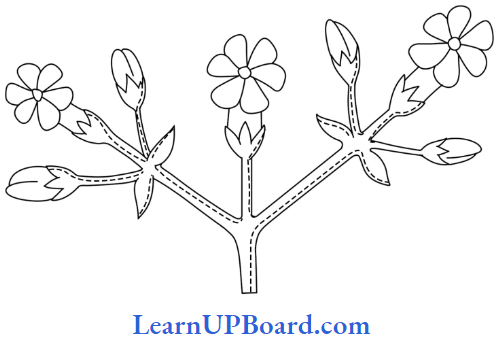
Special Inflorescence: These are of the following types:
- Vertici Ilaster: A cluster of sessile or subsessile flowers borne on a dichasial cyme ending in a monochasial cyme (scorpioid) in the form of a condensed whorl on either side of the node. For example, Ocimum (Tulsi), and Salvia (Lamiaceae).
- Cyathium: It looks like a single flower. In this cup-shaped involucre encloses a single female flower and a number of male flowers. Each male flower is represented by a single stamen, for example, poinsettia (Euphorbia pulcherrima).
- Hypanthodium: Fleshy receptacle forming a hollow cavity with an apical opening. The flowers are developed on the inner wall of the hollow cavity. The male flowers are situated at the top near the opening. Below them gall flowers are situated which are sterile and at the bottom are situated female flowers with long styles, for example, Ficus (banyan, fig, guar).
- Coenanthium: In Dorstenia, the receptacle becomes saucer-shaped and its margins arc slightly. The florets are arranged as similar to hypanthodium.
NEET Biology Notes For Morphology Of A Flowering Plants Flower
Flower is defined as a highly condensed and modified reproductive shoot. The following points can be mentioned to justify that Flower is a modified shoot.
- Calyx, corolla, androecium, and gynoecium represent four whorls of sterile and fertile leaves borne at different nodes. Sometimes intemode between the calyx and corolla becomes elongated and called as anthophore, for example, Silene, and Dianthus.
- The intemode between corolla and androecium is known as androphore, for example, Passiflora. The intemode between androecium and gynoecium is called as gynophore, for example, Capparis. When androphores and gynophores both are present in the same flower, they are jointly termed as gynandrophores, for example, Gynandropsis, Cleome. The prolongation of the thalamus beyond the carpel is known as carpophore, for example, Coriandrum, and Foeniculum.
- In Mussaenda, sepals enlarge to form a leafy structure (foliaceous sepals).
- Sometimes floral bud is transformed into vegetative buds or bulbils, for example, Agave.
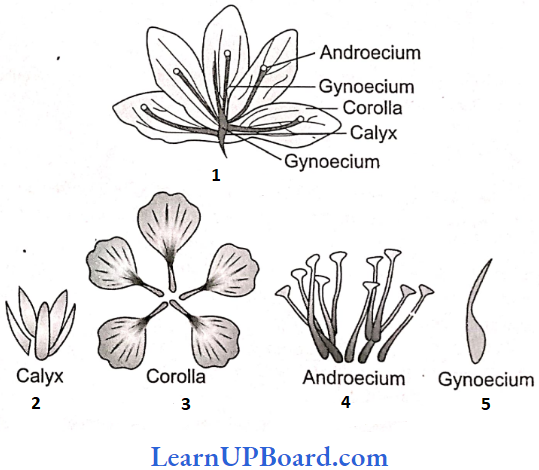
Types Of Floral Characters
- Complete Flower: Calyx, corolla, androecium, and gynoecium are present.
- Incomplete Flower: Flower with one of the four whorls missing.
- Bisexual Flower: Both gynoecium and andoecium are present in the same flower.
- Unisexual Flower: Only androecium (staminate flower) or gynoecium (pistillate flower) are present in the flower.
- Monoecious Plant: When both male and female flowers are present on the same plant. Examples, are Cocos, Ricinus, Zea, Colocasia, and Acalypha.
- Dioecious Plant: When male and female flowers are present on separate plants. Examples are mulberry and papaya.
- Polygamous Plant: When unisexual (male or female), bisexual and neuter flowers are present on the same plant. Example, Polygonum, Mango.
- Monocarpic Plant: The plant that produces flowers and fruits only once in life. For example, pea, mustard, or all seasonal plants.
- Polycarpic Plant: The plant which produces flowers and fruits many times in life. Example, mango, and pear (mostly fruit trees).
- Achlamydeous Flower: Flowers are naked without sepals and petals. Example, Pipelaceae.
- Monochlamydeous Flower: Only one whorl is present (perianth). Examples, are Polygonaceae, and Liliaceae.
- Dichiamydeous Flower: Both whorls are present in a flower Example, most of the flowers.
- Hemicyclic Or Spirocyclic Flowers: Some of the floral parts are in circles and some are spirally arranged. Example, Ranunculaceae.
- Cauliflory: Production of flowers on old stems from dormant buds. Examples, are Artocarpus, and Ficus.
Symmetry Of Flower
- Actinomorphic Flower: When a flower can be divided into two equal halves by many vertical sections passing through the center. Example, Cruciferae, Malvaceae.
- Zygomorphic Flower: When a flower can be divided into two equal halves by only one vertical section passing through the center. For example, pea.
“morphology of flowering plants class 11 pdf notes “
Position Of Floral Parts On Thalamus
- Hypogyny: Ovary is at the top and separable from thalamus. Flowers are hypogynous and the ovary is superior. For example, Malva, Brassica.
- Perigyny: Ovary is hail superior, half inferior. For example, rose.
- Epigyny: Calyx and corolla arise from the upper side of the ovary. The ovary is completely surrounded by and fused with the thalamus. The ovary is inferior and the flower is epigynous. Example, Aster, Luffa.
Bracts: Bracts are specialized leaves that arise from the axil of leaves. They are of the following types:
- Petaloid Bracts: Bracts look like petals (brightly colored). Example, Bougainvillea.
- Spathy Bract: This is a large bract enclosing an inflorescence. Examples are bananas, maize, and palms.
- Foliaceous Bracts: Bracts are leaf-like in appearance. Examples, are Adhatoda, and Gynandropsis.
- Involucre: They are green-colored and in one or more whorls a round or below the entire inflorescence. Examples are sunflower and coriander.
- Glumes: These are small dry, scaly bracts found in spikelet of Gramineae. For example, wheat.
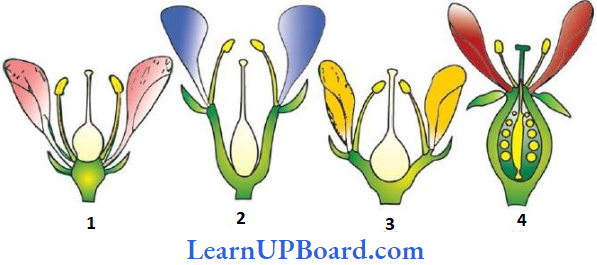
Calyx: The lowermost whorl of a flower is called calyx. It is the non-essential whorl and consists of sepals. Sepals may be free (polysepalous) or fused (gamosepalous). Sepals are modified as follows:
- Pappus: Sepals are modified into persistent hairy structures called pappus which help in the dispersal of fruits. Examples are sunflower and Sonchus (Asteraceae).
- Leafy: In Mussaenda, one sepal is modified into a large leaf-like white structure.
- Spinous: In Trapa, the calyx is persistent and modified into two spines.
Corolla: Corolla is the second whorl of flower and consists of a number of petals which are usually brightly colored. The petals may be gamopetalous (fused) or polypetalous (free). Various forms of petals are:
- Cruciform: Four petals arranged like a cross. For example, members of Brassicaceae.
- Papilionaceous: The number of petals is five with the largest petal standard or vexillum enclosing two lateral wings which are free and in turn enclose the innermost keel (united petals). For example, pea.
- Rosaceous: Five or many small-clawed petals and spread regularly outward. For example, rose.
- Caryophyllaceous: Five free long-clawed with limbs spread at right angles to claws. Example, Diantnus.
- Tubular: Petals are like a tube, for example, disc florets of sunflowers.
- Infundibuliform Or Funnel Shaped: Petals are like a funnel. For example, Datura.
- Bilabiate (Two-Lipped): Upper and lower lips are formed by a fusion of petals. Example, Salvia, Ocimum.
- Ligulate Or Strap Shaped: Gamopetalous petals forming tongue-like structure. For example, ray florets of sunflower.
- Campanulate Or Bell-Shaped: Petals like bell. For example, Physalis.
- Rotate Or Wheel Shaped: Example, brinjal.
Aestivation: The arrangement of floral parts in a floral bud is known as aestivation. It may be of the following types:
- Valvate: When sepals or petals lie very close to each other, without overlapping. For example, mustard.
- Twisted or contorted: When one margin of the sepal or petal overlaps the margin of the next and the other margin is overlapped by the third one. For example, China rose.
- Imbricate: When both margins of one of the petals are covered by others and both margins of another one are external, and of the remaining partly internal, partly external. Example, Cassia, Caesalpinia.
- Quincuncial: When two are inner, two are outer, and one is partly outer and partly inner, Example, Ranunculus.
- Vexillary: The posterior one is the largest and almost covers the two lateral petals and the latter in turn nearly overlaps the two anterior petals. For example, pea (Papilionaceae).
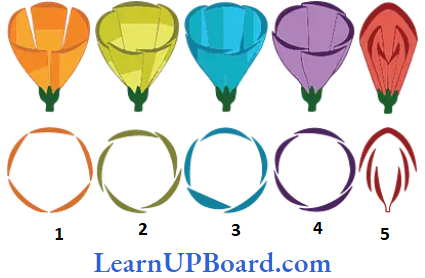
Androecium: It is the third and male whorl of flower in which each stamen consists of filament, anther, and connective. When stamens are free, it is called polyandrous, for example, lily, mustard, and radish. A two-lobed anther is called vitreous (for example, pea) and a one-lobed anther is called monoecious (for example, members of Malvaceae). Attachment of filament to the anther is categorized as:
- Adnate: The filament runs along the back to the anther. For example, Michelia (Champa).
- Basifixed: The Anther is fixed to the filament by its base. For example, Datura.
- Dorsifixed: The Anther is fixed to the filament by its back and the other is immobile. For example, passion flower.
- Versatile: Anther is attached to the filament as in dorsifixed but is able to swing freely. For example, wheat and grasses.
Cohesion Of Stamens: The fusion of stamens among themselves is called cohesion. It is of the following types:
- Monadelphous: Stamens may be united by means of their filaments in one bundle. Examples are China rose, lady’s finger, and cotton (Malvaceae).
- Diadelphous: When the filaments are united into two bundles, the anthers remain free. Examples are peas, beans, and gram (Papilionaceae).
- Polyadelphous: When the filaments are united into more than two bundles but anthers are free. Examples are castor (Euphorbiaceae), and lemon (Rutaceae).
- Syngenesious: When anthers are united but the filaments are free. For example, sunflower (Compositae).
- Synandrous: When anthers as well as filaments of stamens are united throughout their whole length. For example, members of Cucurbitaceae.
Adhesion Of Statements: Fusion with other floral parts is called adhesion. It is of the following types:
- Epipetalous: When stamens are united to the petals. For example, China rose, Solatium, sunflower.
- Episepalous: When stamens are united to sepals. Example, Verbena.
- Epiphyllous (Epipetalous): When stamens are united to perianth (tcpal). For example, members of Liliaceae.
- Gynaiidrous: When stamens are attached to the gynoecium (carpel) either throughout their whole length or by their anthers only. For example, Calotropis (forming gynostegium).
Length And Arrangement Of Stamens
- Didynamous: Four stamens, two outer small and two inner long. Examples, are Ocimum, and Salvia (Labiatae).
- Tetradynamous: Six stamens, two outer small and four inner long. Example, mustard, and radish (Brassicaceae).
- Heterostemony: Stamens are of different lengths. Example, Cassia.
- Obdiplostemonous: Two whorls of stamens, outer whorl lying opposite to the petals (antipetalous) and inner whorl lying opposite to sepals (antisepalous). Examples, are Steilaria, Spergnla, and members of Rutaceae.
- Diplostemonous: Two whorls of stamens, outer whorl Tying opposite to sepals (antisepalous) and inner whorl lying opposite to petals (antipetalous). Example, Cassia.
Gynoecium: It is the female part of the flower comprising carpels bearing ovules. It consists of an ovary, style, and stigma. The gynoecium may be monocarpellary or polycarpellary.
Cohesion Of Carpels
- Apocarpous: Carpels are free (no cohesion). Example, Ranunculaceae.
- Syncarnous: Carpels of more than two and fused. For example, most of the plants.
- Number Of Locules: Ovary has locules or chambers and may be unilocular, bilocular, trilocular, tetralocular, or pentalocular (multilocular).
Placentation: The arrangement of ovules on the placenta within the ovary is called placentation. It is of the following types:
- Marginal: Placenta developing along the junction of two margins of the carpel in a one-chambered ovary. It is the characteristic feature of the family Leguminosae. Example, pea, gram.
- Parietal: Ovary is one-chambered and the placentae bearing the ovules develop on the inner wall of the ovary.
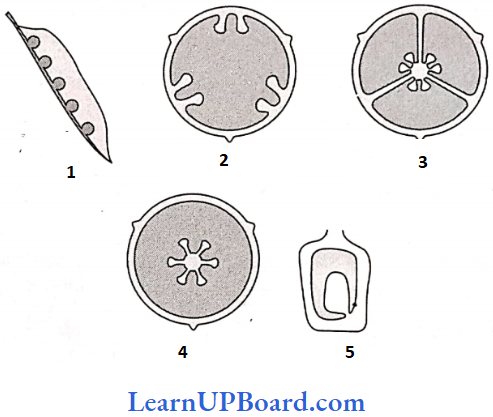
The number of placentae corresponds to the number of carpels. Examples are mustard, radish, and cucumber.
- Axile: The ovary is two to many chambered and placenta-bearing ovules develop from the central axis. Examples are tomato, orange, cotton, China rose, and lily.
- Free Central: Ovary is one-chambered and the placenta bearing the ovules develops all around the central axis. Example, Dianthus, Steilaria.
- Basal: The ovary is unilocular and the placenta develops at the base of the ovary on the thalamus and bears a single ovule. Examples are wheat, maize, aster, Zinnia, and sunflower. It is the most advanced arrangement.
- Superficial: Ovary is multilocular with numerous carpels as in the axile type of placentation, but the placenta develops all around the inner surface of the partition wall. For example, water lily. It is the most primitive.
NEET Biology Notes For Morphology Of A Flowering Plants Fruits
A fertilized and ripened ovary is called a fruit. The fruit consists of seed and pericarp (fruit wall). The pericarp develops from the wall of the ovary and is differentiated into epicarp, mesocarp, and endocarp. Seeds develop from ovules. In some plants, the ovary grows into fruit without fertilization. Such fruits are called parthenocarpic fruits. They are seedless, for example, banana, grapes, pineapple, oranges.
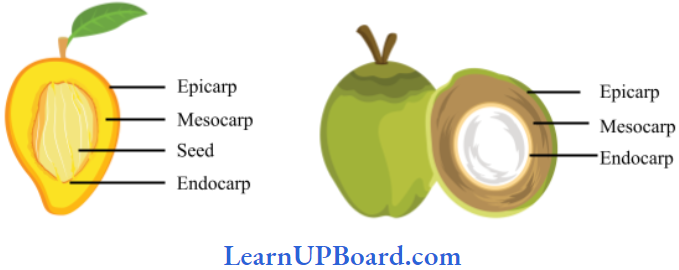
The fruit that develops from ovary is called the true fruit. Most of the fruits are true fruits. If any other floral part takes part in fruit formation, it is called false fruit (pseudocarp), for example, apple, or pear.
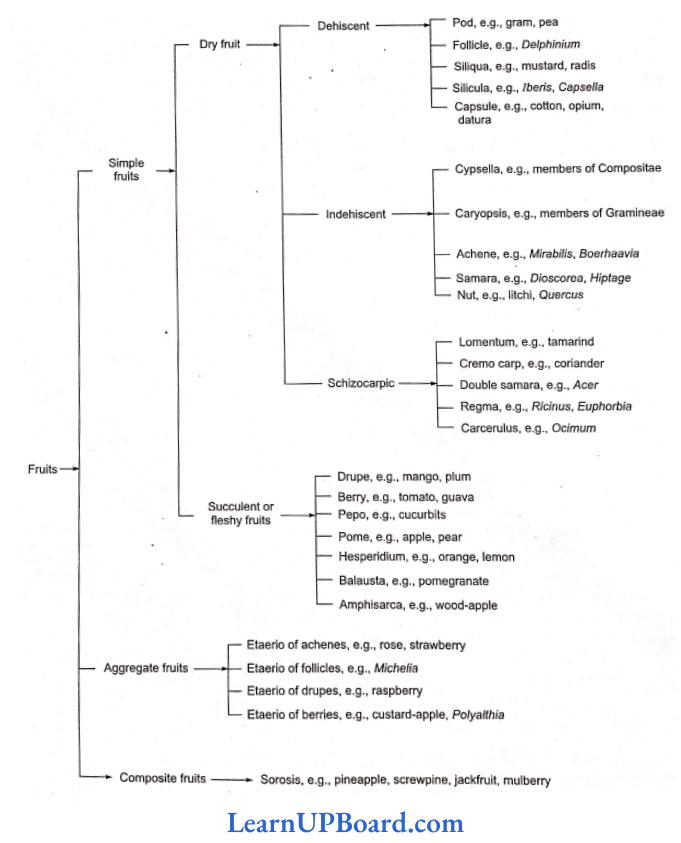
Types Of Fruits
- Simple Fruit: These are developed from the ovary of the single flower with or without accessory parts.
- Dry Indehiscent Fruits: They do not split or burst. Seeds are liberated only by the destruction of the pericarp.
- Dry Dehiscent Fruits: These fruits burst automatically and discharge their seeds.
- Dry Schizocarpic Fruits: They are intermediate between dehiscent and indehiscent fruits. One-seeded indehiscent parts are called mericarps while dehiscent one-seeded are termed cocci.
- Fleshy Or Succulent Fruits: Pericarp and associated structure become fleshy.
- Aggregate Fruits: These fruits are formed from polycarpel lary, apocaipous ovary. Each carpel develops into a fruitlet and all fruitlets together form an aggregate fruit. An aggregate of simple fruits borne, by a single flower is otherwise known as etaerio.
- Multiple Or Composite Fruits: These fruits develop from the entire inflorescence. Sorosis develops from the spike, spadix, or catkin inflorescence. Syconus develops from hypanthium inflorescence.
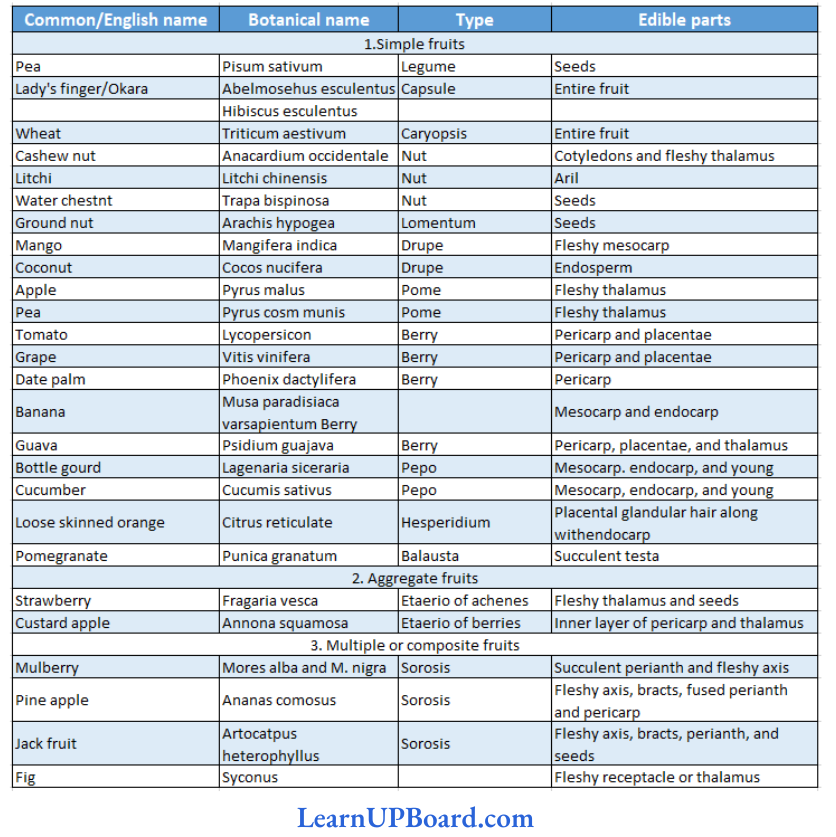
NEET Biology Notes For Morphology Of A Flowering Plants Seed
Morphologically, a ripened ovule is known as a seed. In other words, seed is A mature, integumented megasporangium. Seeds arc characteristic of spermatophytes (gymnosperms and angiosperms).
Parts Of Seed
Seed Coat: The outer, protective covering of the seed is called the seed coat, which develops from integuments of the ovule. In seeds developing from bitegmic ovules, there are two distinct layers in the seed coat. The outer layer is thick, hard, and leathery (developing from the outer integument) called the testa, whereas the inner layer is thick and papery (developing from the inner in-tegument) called legmen. In seeds developing from unitegmic ovules, there is a single-layered seed coat.
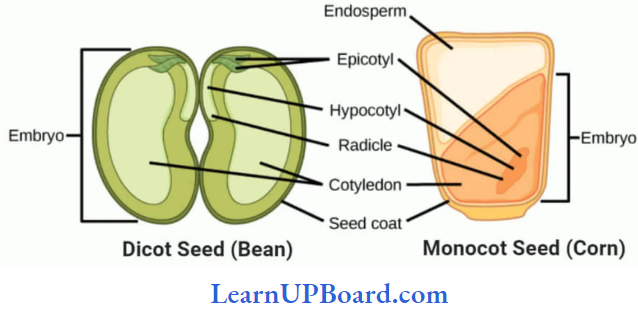
Embryo: The embryo is the most important part of the seed which represents a tiny future plant. The embryo has an embryonal axis or main axis called tigellum, to which one or two cotyledons (seed) are attached, depending upon whether the seed is monocot or dicot. The portion of the embryonal axis or flagellum below the point of attachment of cotyledons is called hypocotyl, which bears a radicle or future root at its tip. Similarly, the portion of the embryonal axis or flagellum above the point of attachment of cotyledons is called epicotyl, which bears plumule.
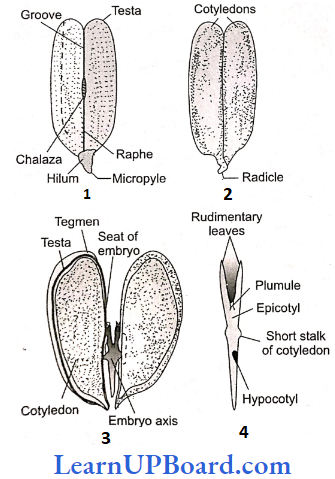
In some seeds (for example, legumes), the reserve food is stored in cotyledons, whereas in others (for example, cereals), there is a special nutritive tissue called endosperm. The seeds having endosperm are called endospermic or albuminous seeds, for example, cereals, castor, etc., whereas seeds in which the endosperm is fully consumed by the embryo and no endosperm is left are called non-endospermic or exalbuminous seeds, for example, gram, pea, cucumber, tamarind, etc. The reserve food materials in seeds may be carbohydrates (for example, wheat, rice) proteins (legumes) fats (castor, peanut, sunflower), etc. All structures inside the seed coat constitute the kernel.
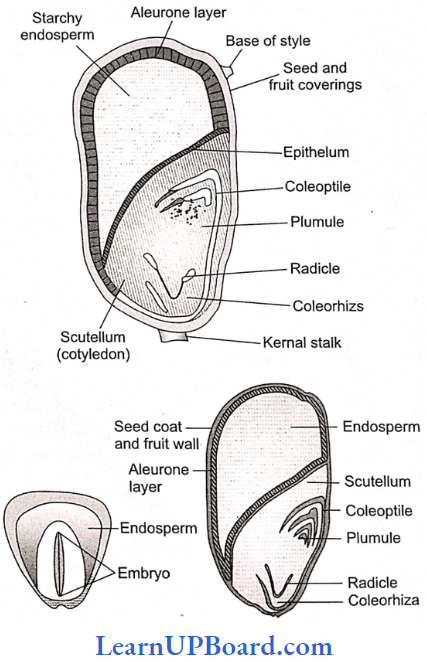
Monocot Embryo: There is a single cotyledon called scutellum, which is attached to the mid-part of the embryonal axis on its lateral side. On the opposite side of the scutellum is present a tongue-shaped flap-like outgrowth called epiblast (for example, wheat) which represents reduced cotyledon. Further, there is a covering or sheath of the radicle called coleorhiza and a sheath of the plumule called coleoptile.
In Castor Seed (Ricinus Communis): There is a specific outgrowth called caruncle or strophiole, present over the hilum. It is formed by the proliferation of cells of the outer integument at the tip. Caruncle is somewhat spongy and helps in the absorption of water during the germination of seed.
Pcrispermic Seeds: Mostly nucellus is consumed after fertilization due to the absorption of food by the endosperm and embryo. The remains are of nucellus in the seed are called perisperm. Such seeds are called pcrispermic seeds, for example, Piper nigrum (black pepper).
Chalazosperimic Seeds: Chalazosperm is perisperm-like tissue in chalazal region. It is a substitute for endosperm, for example, Cynastrum.
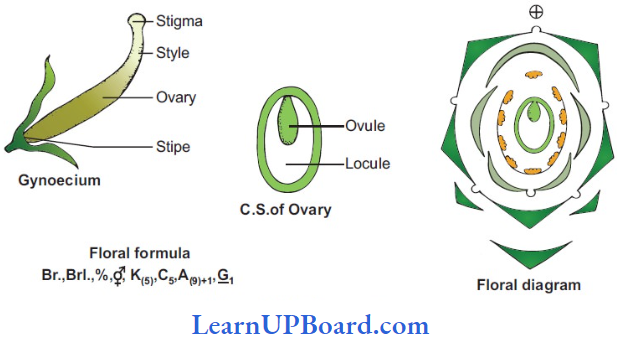
Economic Importance Of Papilionaceae
- Source of pulses (gram, arhar, mung, etc.)
- Edible oil (soybean, groundnut)
- Dye (Indigofera)
- Fodder (sesbania, Trifolium)
- Ornamentals (lupin, sweet pea)
- Medicine (mulethi)
Economic Importance Of Solanaceae
- Source of food (tomato, brinjal, potato)
- Spice (chili)
- Medicine (belladonna, ashwagandha)
- Fumigalory (tobacco)
- Ornamentals (petunia)
Economic Importance Of Liliaceae
- Good ornamentals (tulip, Gloriosa)
- Source of medicine {Aloe) and vegetables (Asparagus)
- Colchicine (Colchicum autumnale)
NEET Biology Notes For Morphology Of A Flowering Plants Points To Remember
Style is generally terminal but may be lateral, for example, Graminae, or mango. Gynobasic style arises from the base of the ovary, for example, Labiatae.
- Examples of endospermic dicot seeds are castor, papaya, and cotton.
- Examples of non-endospermic dicot seeds are gram, bean, pea, cucumber, and tamarind.
- Examples of endospermic monocot seeds are maize, rice, and wheat.
Examples Of Non-endospermic Monocot Seeds: are pothos (money plant), Vallisneria, Alisina, and Amotphophallns.
Defense Mechanisms In Plants
- Thoms: Lemon, pomegranate, Duranta
- Spines: Agave, Yucca
- Prickles: Agave, cotton tree, rose
- Stinging Hair: Laportea, Urtica clioica
- Glandular Hair: Jatropha, Boerhavia, Tobacco
- Stiff Hair: Guaphalium
- Latex: Ficus, Nerium, Euphorbia
- Alkaloids: Poppy, Datura
- Geophilous Habit: Ginger, turmeric. Colocasia, onion
- Myremecophily: Guava, mango, litchi
- Mimicry: Cladium, Sansevieria
Anemochory is common in orchids and grasses. The jaculator mechanism in Ruellia and the fountain mechanism in Ecballiurn are related to autochory.
NEET Biology Notes For Morphology Of A Flowering Plants Assertion Reasoning Questions And Answers
In the following questions, an Assertion (A) is followed by a corresponding Reason (R). Mark the correct answer.
- If both Assertion and Reason are true and the Reason is the correct explanation of the Assertion.
- If both Assertion and Reason are true, but the Reason is not the correct explanation of the Assertion.
- If Assertion is true, but Reason is false.
- If both Assertion and Reason are false.
Question 1.
Assertion: In head inflorescence, florets are arranged centrifugally.
Reason: There are always two types of florets in head.
Answer: 4. If both Assertion and Reason are false.
Question 2.
Assertion: Staminal tube is present in Malvaceae.
Reason: It is due to a monetary condition.
Answer: 1. If both Assertion and Reason are true and the Reason is the correct explanation of the Assertion.
Question 3.
Assertion: The nest of Dischidia is a modified structure of the root.
Reason: Nest roots absorb water and food from humus-rich soil collected in the nest.
Answer: 4. If both Assertion and Reason are false.
Question 4.
Assertion: The lower feathery end of the tigellum is known as a radicle.
Reason: Tigellum bears two nodes on which one or two cotyledons develop.
Answer: 4. If both Assertion and Reason are false.
Question 5.
Assertion: There are five alae in the Pisitm sativum flower.
Reason: Both alae are covered by the largest petal.
Answer: 2. If both Assertion and Reason are true, but the Reason is not the correct explanation of the Assertion.
Question 6.
Assertion: All floral whorls are supposed to be modified leaves.
Reason: A Flower is considered as a modified shoot bearing floral parts on its nodes.
Answer: 1. If both Assertion and Reason are true and the Reason is the correct explanation of the Assertion
Question 7.
Assertion: Young leaves in Poinsettia are brightly colored to attract pollinators and achieve pollination.
Reason: It is only a bright color that can attract pollinators on all plants.
Answer: 3. If Assertion is true, but Reason is false.
Question 8.
Assertion: Schizocarpic fruits arc intermediate between dehiscent and indehiscent fruits.
Reason: These fruits split into single-seeded parts.
Answer: 1. If both Assertion and Reason are true and the Reason is the correct explanation of the Assertion.
Question 9.
Assertion: Leaf in Opuntia functions for the storage of sugars.
Reason: Sugar is transported from leaves in Opuntia and gets stored in the stem.
Answer: 4. If both Assertion and Reason are false.
Question 10.
Assertion: Prop roots develop mostly from horizontal branches of main stem.
Reason: Adventitious roots may perform mechanical supporting functions, working as ropes of a tent.
Answer: 2. If both Assertion and Reason are true, but the Reason is not the correct explanation of the Assertion.
